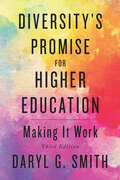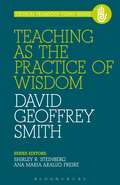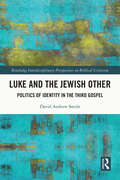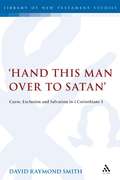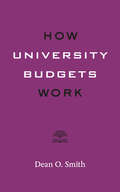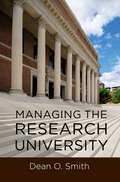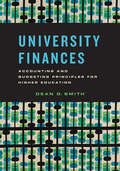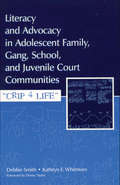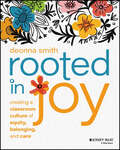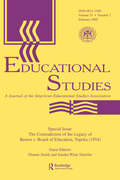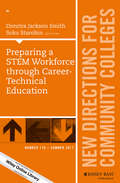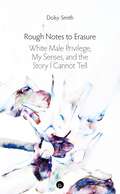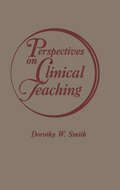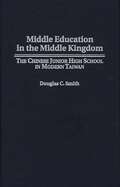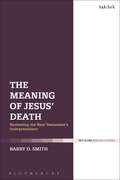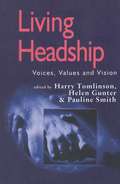- Table View
- List View
Diversity's Promise for Higher Education: Making It Work
by Daryl G. SmithDaryl G. Smith has devoted her career to studying and fostering diversity in higher education. In Diversity's Promise for Higher Education, Smith brings together research from a wide variety of fields to propose a set of clear and realistic practices that will help colleges and universities locate diversity as a strategic imperative and pursue diversity efforts that are inclusive of the varied—and growing—issues apparent on campuses without losing focus on the critical unfinished business of the past.To become more relevant to society, the nation, and the world, while remaining true to their core missions, colleges and universities must continue to see diversity—like technology—as central, not parallel, to their work. Indeed, looking at the relatively slow progress for change in many areas, Smith suggests that seeing diversity as an imperative for an institution's individual mission, and not just as a value, is the necessary lever for real institutional change. Furthermore, achieving excellence in a diverse society requires increasing institutional capacity for diversity—working to understand how diversity is tied to better leadership, positive change, research in virtually every field, student success, accountability, and more equitable hiring practices. In this edition, which is aimed at administrators, faculty, researchers, and students of higher education, Smith emphasizes a transdisciplinary approach to the topic of diversity, drawing on an updated list of sources from a wealth of literatures and fields. The tables and figures have been refreshed to include data on faculty diversity over a twenty-year period, and the book includes new information about • gender identity,• embedded bias,• student success,• the growing role of chief diversity officers,• the international emergence of diversity issues,• faculty hiring,• and important metrics for monitoring progress.Drawing on forty years of diversity studies, this third edition also • includes more examples of how diversity is core to institutional excellence, academic achievement, and leadership development;• updates issues of language;• examines the current climate of race-based campus protest;• addresses the complexity of identity—and explains how to attend to the growing kinds of identities relevant to diversity, equity, and inclusion while not overshadowing the unfinished business of race, class, and gender.
Diversity's Promise for Higher Education: Making It Work
by Daryl G. SmithDaryl G. Smith has devoted her career to studying and fostering diversity in higher education. In Diversity's Promise for Higher Education, Smith brings together research from a wide variety of fields to propose a set of clear and realistic practices that will help colleges and universities locate diversity as a strategic imperative and pursue diversity efforts that are inclusive of the varied—and growing—issues apparent on campuses without losing focus on the critical unfinished business of the past.To become more relevant to society, the nation, and the world, while remaining true to their core missions, colleges and universities must continue to see diversity—like technology—as central, not parallel, to their work. Indeed, looking at the relatively slow progress for change in many areas, Smith suggests that seeing diversity as an imperative for an institution's individual mission, and not just as a value, is the necessary lever for real institutional change. Furthermore, achieving excellence in a diverse society requires increasing institutional capacity for diversity—working to understand how diversity is tied to better leadership, positive change, research in virtually every field, student success, accountability, and more equitable hiring practices. In this edition, which is aimed at administrators, faculty, researchers, and students of higher education, Smith emphasizes a transdisciplinary approach to the topic of diversity, drawing on an updated list of sources from a wealth of literatures and fields. The tables and figures have been refreshed to include data on faculty diversity over a twenty-year period, and the book includes new information about • gender identity,• embedded bias,• student success,• the growing role of chief diversity officers,• the international emergence of diversity issues,• faculty hiring,• and important metrics for monitoring progress.Drawing on forty years of diversity studies, this third edition also • includes more examples of how diversity is core to institutional excellence, academic achievement, and leadership development;• updates issues of language;• examines the current climate of race-based campus protest;• addresses the complexity of identity—and explains how to attend to the growing kinds of identities relevant to diversity, equity, and inclusion while not overshadowing the unfinished business of race, class, and gender.
Teaching as the Practice of Wisdom (Critical Pedagogy Today)
by David SmithIn the spirit of Paulo Freire, this inspiring book deconstructs many of the 'gods' that define contemporary life, then offers hope through sources of traditional wisdom. It addresses important contemporary discourses in the political and social sciences in ways that are relevant to the personal and professional lives of teachers at all levels of educational practice. David G. Smith discusses the impacts on teachers' lives of neoconservativism, neoliberalism, the New Marxism, the emerging paradigm of Deep Politics, global Wisdom traditions, and more - and he reveals how teachers can creatively stand with or against these streams of influence. By clearly relating larger theoretical discussions in the social sciences to the policies and practices of teaching, Smith builds upon Freire's legacy. He also reaches beyond debates in Western scholarship, and accesses new theory from the global "South", from Buddhist and NeoConfucian traditions as well as the new African Renaissance stream known as Unhu/Ubuntu. This is a powerful work of educational theory and philosophy that contains useful advice for educators wishing to push back against conformity.
Teaching as the Practice of Wisdom (Critical Pedagogy Today)
by David SmithIn the spirit of Paulo Freire, this inspiring book deconstructs many of the 'gods' that define contemporary life, then offers hope through sources of traditional wisdom. It addresses important contemporary discourses in the political and social sciences in ways that are relevant to the personal and professional lives of teachers at all levels of educational practice. David G. Smith discusses the impacts on teachers' lives of neoconservativism, neoliberalism, the New Marxism, the emerging paradigm of Deep Politics, global Wisdom traditions, and more - and he reveals how teachers can creatively stand with or against these streams of influence. By clearly relating larger theoretical discussions in the social sciences to the policies and practices of teaching, Smith builds upon Freire's legacy. He also reaches beyond debates in Western scholarship, and accesses new theory from the global "South", from Buddhist and NeoConfucian traditions as well as the new African Renaissance stream known as Unhu/Ubuntu. This is a powerful work of educational theory and philosophy that contains useful advice for educators wishing to push back against conformity.
Luke and the Jewish Other: Politics of Identity in the Third Gospel (Routledge Interdisciplinary Perspectives on Biblical Criticism)
by David Andrew SmithLuke and the Jewish Other takes up the debated question of the orientation of Luke towards the Jewish people. Building on recent studies in the social history of early Jewish-Christian relations, it offers an analysis of Luke’s portrayal of Jewish and Christian identities that challenges the common assumption that the construction of religious identity in antiquity necessarily depended upon antagonistic relations with others. Taking account of the deep and often divisive difference that belief in Jesus made in Luke’s community, the author argues that Luke hoped to bring about both a rapprochement with and the conversion of contemporary Jews. Through this account of identity and alterity in the Gospel of Luke, the book cuts across boundaries of biblical studies, history, theology, and social theory, proposing a way forward for the study of Luke’s relation to Judaism and of the "parting of the ways" between Jews and Christians in the early Common Era.
Luke and the Jewish Other: Politics of Identity in the Third Gospel (Routledge Interdisciplinary Perspectives on Biblical Criticism)
by David Andrew SmithLuke and the Jewish Other takes up the debated question of the orientation of Luke towards the Jewish people. Building on recent studies in the social history of early Jewish-Christian relations, it offers an analysis of Luke’s portrayal of Jewish and Christian identities that challenges the common assumption that the construction of religious identity in antiquity necessarily depended upon antagonistic relations with others. Taking account of the deep and often divisive difference that belief in Jesus made in Luke’s community, the author argues that Luke hoped to bring about both a rapprochement with and the conversion of contemporary Jews. Through this account of identity and alterity in the Gospel of Luke, the book cuts across boundaries of biblical studies, history, theology, and social theory, proposing a way forward for the study of Luke’s relation to Judaism and of the "parting of the ways" between Jews and Christians in the early Common Era.
'Hand this man over to Satan': Curse, Exclusion and Salvation in 1 Corinthians 5 (The Library of New Testament Studies #386)
by David Raymond Smith1 Corinthians 5:5 is a curious passage which has been variously interpreted by scholars. For some, it denotes a magical curse which is designed to cause the physical death of the sinner. Others have found such an interpretation unpersuasive. Instead, they maintain that Paul's words at verse five are to be understood as a metaphor for exclusion from the Corinthian community. So, the errant Corinthian is not to die by a curse, but is to be excluded. This work argues for the former interpretation by marshalling a range of the most recent-specialised-magical material, which has not been considered by other works in relation to 1 Corinthians 5. It fully acknowledges the weaknesses of previous magical interpretations, and metaphorical approaches to the passage. Instead, it presents a fresh magical reading of not only 1 Corinthians 5:5, but the whole of 1 Corinthians 5-within its wider context of the apostle Paul's letter to the Corinthians.
How University Budgets Work (Higher Ed Leadership Essentials)
by Dean O. SmithTo understand how universities function, it is critical to understand how their budgets work. In this useful volume, Dean O. Smith provides a concise explanation of university budgets—why they're important, how they are prepared, what information they provide, and how they are monitored.Translating technical jargon into layman's terms, How University Budgets Work emphasizes practical matters and best practices. Writing for a non-specialist audience, Smith covers major aspects of university budgets ranging from their preparation and alignment with strategic plans to their implementation at the departmental level. Offering time-tested advice from his many years in higher administration, he also touches on • expenditure monitoring• projections• allocations• revenue• incentives • financial reserves• end-of-year accounting The companion book to the more rigorous University Finances, also by Smith, How University Budgets Work is a unique introductory guide for the extended academic community. Ultimately, this logical, accessible book provides a working knowledge of how university budgets are produced and implemented, one that enables faculty members and administrators to become more effective in their roles within the university.
How University Budgets Work (Higher Ed Leadership Essentials)
by Dean O. SmithTo understand how universities function, it is critical to understand how their budgets work. In this useful volume, Dean O. Smith provides a concise explanation of university budgets—why they're important, how they are prepared, what information they provide, and how they are monitored.Translating technical jargon into layman's terms, How University Budgets Work emphasizes practical matters and best practices. Writing for a non-specialist audience, Smith covers major aspects of university budgets ranging from their preparation and alignment with strategic plans to their implementation at the departmental level. Offering time-tested advice from his many years in higher administration, he also touches on • expenditure monitoring• projections• allocations• revenue• incentives • financial reserves• end-of-year accounting The companion book to the more rigorous University Finances, also by Smith, How University Budgets Work is a unique introductory guide for the extended academic community. Ultimately, this logical, accessible book provides a working knowledge of how university budgets are produced and implemented, one that enables faculty members and administrators to become more effective in their roles within the university.
Managing the Research University
by Dean O. SmithManaging the Research University provides a comprehensive background and discussion of all major topics encountered routinely in managing the academic research enterprise. It serves as a surrogate mentor by providing advice and guidance on best practices that set the professional standards for academic research management.
University Finances: Accounting and Budgeting Principles for Higher Education
by Dean O. SmithIn University Finances, higher education expert Dean O. Smith ;€¢ demystifies basic accounting procedures, budgets, debt financing, and financial statements;€¢ explores more unusual financial topics, such as methods for calculating fringe benefit rates, bond refunding costs, and indirect cost allocations;€¢ shows that the use of university wealth is highly restricted by donors, bondholders, government regulators, and others;€¢ answers nuanced questions, like "How are USDA formula funds calculated?" and "Why does the university pursue more and more research funding when it loses money on every grant?";€¢ illustrates financial calculations using realistic examplesSome of these explanations are unavailable in print or online to anyone but a handful of professional accountants. Rigorous, detailed, and wide-ranging, University Finances is a unique and powerful resource.
University Finances: Accounting and Budgeting Principles for Higher Education
by Dean O. SmithIn University Finances, higher education expert Dean O. Smith ;€¢ demystifies basic accounting procedures, budgets, debt financing, and financial statements;€¢ explores more unusual financial topics, such as methods for calculating fringe benefit rates, bond refunding costs, and indirect cost allocations;€¢ shows that the use of university wealth is highly restricted by donors, bondholders, government regulators, and others;€¢ answers nuanced questions, like "How are USDA formula funds calculated?" and "Why does the university pursue more and more research funding when it loses money on every grant?";€¢ illustrates financial calculations using realistic examplesSome of these explanations are unavailable in print or online to anyone but a handful of professional accountants. Rigorous, detailed, and wide-ranging, University Finances is a unique and powerful resource.
Literacy and Advocacy in Adolescent Family, Gang, School, and Juvenile Court Communities: Crip 4 Life
by Debra Smith Kathryn F. WhitmoreThe goal of this book is to encourage educators and researchers to understand the complexities of adolescent gang members' lives in order to rethink their assumptions about these students in school. The particular objective is to situate four gang members as literate, caring students from loving families whose identities and literacy keep them on the margins of school. The research described in this book suggests that advocacy is a particularly effective form of critical ethnography. Smith and Whitmore argue that until schools, as communities of practice, enable children and adolescents to retain identities from the communities in which they are full community members, frightening numbers of students are destined to fail.The stories of four Mexican American male adolescents, who were active members of a gang and Smith's students in an alternative high school program, portray the complicated, multiple worlds in which these boys live. As sons and teenage parents they live in a family community; as CRIP members they live in a gang community; as "at risk" students, drop-outs, and graduates they live in a school community, and as a result of their illegal activities they live in the juvenile court community. The authors theorize about the boys' literacy in each of their communities. Literacy is viewed as ideological, related to power, and embedded in a sociocultural context. Vivid examples of conversation, art, tagging, rap, poetry, and other language and literacy events bring the narratives to life in figures and photographs in all the chapters. Readers will find this book engaging and readable, yet thought provoking and challenging.Audiences for Literacy and Advocacy in Adolescent Family, Gang, School, and Juvenile Court Communities include education researchers, professionals, and students in the areas of middle/high school education, at-risk adolescent psychology, and alternative community programs--specifically those interested in literacy education, sociocultural theory, and popular culture.
Literacy and Advocacy in Adolescent Family, Gang, School, and Juvenile Court Communities: Crip 4 Life
by Debra Smith Kathryn F. WhitmoreThe goal of this book is to encourage educators and researchers to understand the complexities of adolescent gang members' lives in order to rethink their assumptions about these students in school. The particular objective is to situate four gang members as literate, caring students from loving families whose identities and literacy keep them on the margins of school. The research described in this book suggests that advocacy is a particularly effective form of critical ethnography. Smith and Whitmore argue that until schools, as communities of practice, enable children and adolescents to retain identities from the communities in which they are full community members, frightening numbers of students are destined to fail.The stories of four Mexican American male adolescents, who were active members of a gang and Smith's students in an alternative high school program, portray the complicated, multiple worlds in which these boys live. As sons and teenage parents they live in a family community; as CRIP members they live in a gang community; as "at risk" students, drop-outs, and graduates they live in a school community, and as a result of their illegal activities they live in the juvenile court community. The authors theorize about the boys' literacy in each of their communities. Literacy is viewed as ideological, related to power, and embedded in a sociocultural context. Vivid examples of conversation, art, tagging, rap, poetry, and other language and literacy events bring the narratives to life in figures and photographs in all the chapters. Readers will find this book engaging and readable, yet thought provoking and challenging.Audiences for Literacy and Advocacy in Adolescent Family, Gang, School, and Juvenile Court Communities include education researchers, professionals, and students in the areas of middle/high school education, at-risk adolescent psychology, and alternative community programs--specifically those interested in literacy education, sociocultural theory, and popular culture.
Rooted in Joy: Creating a Classroom Culture of Equity, Belonging, and Care
by Deonna SmithHow teachers can unlock the power of inclusivity and joy to transform their classroom and behavior management In Rooted in Joy: Creating a Classroom Culture of Equity, Belonging, and Care, educational justice advocate and educator Deonna Smith delivers a unique blend of theory, academic frameworks, narrative, and digestible advice on impacting deeply rooted school culture challenges and managing the day-to-day classroom. This research-based book brings a friendly and accessible voice to a complex issue, making the subject matter easy to follow and apply in the real world. In the book, you’ll build your toolbox for cultivating a inclusive and joyful classroom culture throughhumanizing your students and acknowledging the role that culture and race play in the educational system.You’ll also: Find valuable, downloadable resources that complement and highlight the topics discussed in the book Discover resources suited to first-year teachers, as well as educators with decades of experience in the classroom Discover ways to improve learning outcomes for all students An essential and practical resource for teachers, administrators, principals, and other education leaders, Rooted in Joy will also benefit education policymakers, regulators, and other public officials seeking advice on how to shape the next generation of school policy.
Rooted in Joy: Creating a Classroom Culture of Equity, Belonging, and Care
by Deonna SmithHow teachers can unlock the power of inclusivity and joy to transform their classroom and behavior management In Rooted in Joy: Creating a Classroom Culture of Equity, Belonging, and Care, educational justice advocate and educator Deonna Smith delivers a unique blend of theory, academic frameworks, narrative, and digestible advice on impacting deeply rooted school culture challenges and managing the day-to-day classroom. This research-based book brings a friendly and accessible voice to a complex issue, making the subject matter easy to follow and apply in the real world. In the book, you’ll build your toolbox for cultivating a inclusive and joyful classroom culture throughhumanizing your students and acknowledging the role that culture and race play in the educational system.You’ll also: Find valuable, downloadable resources that complement and highlight the topics discussed in the book Discover resources suited to first-year teachers, as well as educators with decades of experience in the classroom Discover ways to improve learning outcomes for all students An essential and practical resource for teachers, administrators, principals, and other education leaders, Rooted in Joy will also benefit education policymakers, regulators, and other public officials seeking advice on how to shape the next generation of school policy.
The Contradictions of the Legacy of Brown V. Board of Education, Topeka (1954): A Special Issue of Educational Studies
by Dianne Smith Sandra Winn TutwilerFirst Published in 2005. Routledge is an imprint of Taylor & Francis, an informa company.
The Contradictions of the Legacy of Brown V. Board of Education, Topeka (1954): A Special Issue of Educational Studies
by Dianne Smith Sandra Winn TutwilerFirst Published in 2005. Routledge is an imprint of Taylor & Francis, an informa company.
Preparing a STEM Workforce through Career-Technical Education: New Directions for Community Colleges, Number 178 (J-B CC Single Issue Community Colleges)
by Dimitra Jackson Smith Soko StarobinThis volume examines STEM education, preparation, and career exploration--and the role of career and technical education (CTE) in preparing individuals for the STEM workforce. Highlighting avenues for success and exemplary practices, the volume covers topics such as: 1) Incorporating experiential learning activities for students in CTE-STEM programs,2) Providing avenues and effective strategies for closing the skills gap for students in CTE-STEM throughfunding and evaluation and assessment activities, 3) Highlighting the experiences of women in CTE-STEM related programs, and4) Implications for policy and practice. This is the 178th volume of this Jossey-Bass quarterly report series. Essential to the professional libraries of presidents, vice presidents, deans, and other leaders in today's open-door institutions, New Directions for Community Colleges provides expert guidance in meeting the challenges of their distinctive and expanding educational mission.
Preparing a STEM Workforce through Career-Technical Education: New Directions for Community Colleges, Number 178 (J-B CC Single Issue Community Colleges)
by Dimitra Jackson Smith Soko StarobinThis volume examines STEM education, preparation, and career exploration--and the role of career and technical education (CTE) in preparing individuals for the STEM workforce. Highlighting avenues for success and exemplary practices, the volume covers topics such as: 1) Incorporating experiential learning activities for students in CTE-STEM programs,2) Providing avenues and effective strategies for closing the skills gap for students in CTE-STEM throughfunding and evaluation and assessment activities, 3) Highlighting the experiences of women in CTE-STEM related programs, and4) Implications for policy and practice. This is the 178th volume of this Jossey-Bass quarterly report series. Essential to the professional libraries of presidents, vice presidents, deans, and other leaders in today's open-door institutions, New Directions for Community Colleges provides expert guidance in meeting the challenges of their distinctive and expanding educational mission.
Rough Notes to Erasure: White Male Privilege, My Senses, and the Story I Cannot Tell
by Dolsy SmithWe are living through the wrack of the White Male. As the compact between social hierarchy, inherited privilege, and race (reinforced by gender and other normative categories) shows signs of buckling, his rage and resentment threaten us all. For he is a thing possessed: possessed by his own love of possession, and born to a sense that the world belongs to him and him alone. The spoils of oppression lie coiled inside him, a glut he can’t digest, and murder beckons behind the respect that he conceives of as his due." A hybrid of critical essay and memoir, and Rough Notes to Erasure contributes to a growing body of work that wrestles with the tacit and embodied nature of privilege and prejudice, and it contributes not only via argument but also through style. Taking inspiration from feminist/queer poetics and what Fred Moten calls “the black avant-garde,” these rough notes address the remainder that gets lost in explicit argument, which is the flesh. Where privilege roils through history, and empire whets the appetites. But also where the world catches on its own fractalization by thought, feeling, and desire; and language recovers, for a moment or two, the power to entangle us with our mother tongue.
Middle Education in the Middle Kingdom: The Chinese Junior High School in Modern Taiwan
by Douglas C. SmithThis in-depth study of the junior high school years (grades 7-9) in Taiwan, China, compares the Taiwan model with those found in Japan, Korea, Singapore, Hong Kong, and the urban areas of China. Of particular interest are such topics as curriculum, homework, teaching methods, textbooks, school ecology, teacher training, health and safety, parental influence on children, school spirit, peer pressure and mediations, and the use of teaching-to-examination. Comparisons with the American model are coincidental. The author, who has taught in both Asia and the United States, does, however, make generalizations about the dysfunctional American school paradigm and the vigorous nature of academic life in Asia. Smith asserts that the Asian model for educational excellence cannot be transplanted to the United States. Our highly diverse society could not endure the demands of standardized examination at each juncture of education.The author contends that the key factors in success are only slightly related to the school. Family life, peer pressure, the competitive examination system, desire for family honor, and the challenge of the Darwinian milieu all lead to excellent academic outcomes. Social and cultural life for children, though limited, are always seen as complementary to school life. Family activities focus on the child and his or her education. Parental sacrifices are the norm to assure a child's academic and employment success via the conduit of education.
The Meaning of Jesus' Death: Reviewing the New Testament’s Interpretations
by Dr Barry D. SmithBarry D. Smith studies the salvation-historical meaning of Jesus' death (commonly known as the atonement) in the New Testament. Smith works his way through the four theories of the doctrine of the atonement that have emerged in the history of Christian theology: moral influence, governmental, satisfaction and Christus victor theories. Smith works from the premise that, for a theory of the atonement to be successful, no biblical data may be omitted or distorted, and the generalized concepts used to comprehend the biblical data must be easily seen as implicit in the data. From this vantage point, Smith advances a formulation of the atonement that is best supported by the biblical text itself. The conclusion Smith reaches is that the biblical data supports both the penal-substitutionary version of the satisfaction theory and the Christus victor theory of the atonement, each of which should be viewed as two parts of a more inclusive theory of atonement present in the New Testament.
Living Headship: Voices, Values and Vision (PDF)
by Dr Pauline V Smith Professor Harry Tomlinson Professor Helen Gunter`The book has a wide appeal to existing heads, aspiring heads, lecturers and writers about headship. The contributors to this book have lifted the curtain on the realities of headships and, in the process, have added to our understanding of what school leadership is all about these days' - Managing Schools Today Practitioners and trainers understand how vitally important school leadership is to the practice of headship. Living Headship presents the experiences of successful heads working in primary and secondary schools. We hear in their accounts the authentic voices of heads determined to ensure that their leadership enhances the performance of their schools. Some have been in post for many years, and have been able to implement and sustain and reconsider their vision. Others have moved into schools with difficulties and brought them out of special measures. All demonstrate a profound commitment to the education of children and a determination to find ways to take their schools forward. Many of the chapters are underpinned by research, and all are based on a rigorous consideration of particular issues. To set these analyses in context, the editors present an essential, in-depth history of the conceptualization of headship. The deep commitment to learning and the challenge presented here, make this book essential reading for practitioners, trainers and all concerned about the future of education.
